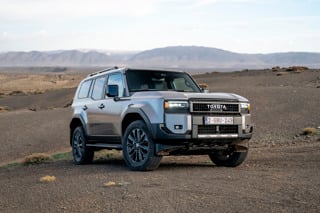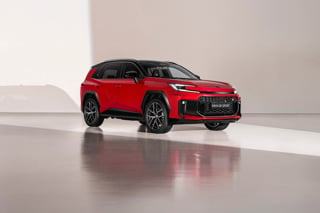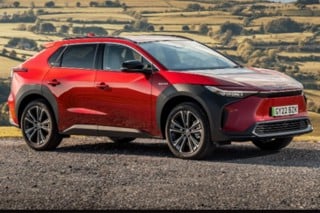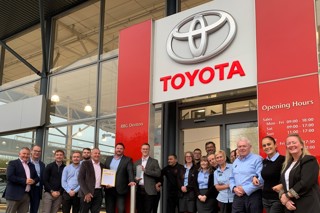[gallery id=1262]
That balance replaces the all-out volume ambition of some other national sales companies – after 18 months in the role, Toyota GB president Paul Van der Burgh makes no claims for UK market domination, no insistence that dealers will double their sales volume by 2020.
What Van der Burgh does talk about at length is quality – of products, of business done, and of customer experience.
[gallery id=1262]
Balance and harmony mean a lot to the senior management at Toyota GB. Balance because the dealer network is finally getting a broader range of products, which bring new sales opportunities after years focused on core models. And harmony because the brand has endured more than its fair share of recent upsets – a fragile economic recovery, the 2011 Japanese tsunami and global recalls that knocked its reputation.
That balance replaces the all-out volume ambition of some other national sales companies – after 18 months in the role, Toyota GB president Paul Van der Burgh makes no claims for UK market domination, no insistence that dealers will double their sales volume by 2020.
What Van der Burgh does talk about at length is quality – of products, of business done, and of customer experience.
Toyota’s leaders believe these are the aspects with which it can build its business.
This comes after Toyota’s 2015 new car registrations, which nudged 100,000, a level the brand has not achieved since 2009. Despite that achievement, Van der Burgh is not aiming to beat it this year – he expects the brand to end 2016 flat in new cars, and down in LCVs due to the late arrival of the new Proace and HiLux.
“Toyota’s ambition is 5% share. We’re not buying share, though. We’re at 4% now and once we have the C-HR crossover (due in early 2017 - see page 83) that will get us to our ambition quite quickly, because the segment is growing strongly,” he said.
One potential fly in the ointment is the private new car market, which has been in decline since April.
Van der Burgh said Toyota tends to be more retail-focused than fleet. This is borne out by SMMT data showing a 55/45% retail/fleet split in 2015 and 52.7%/47.3% for the year to September 30. However, it also shows that there is more corporate demand at the moment than private demand.
“We don’t chase volume at any cost, we compete in the fleet market and have corporate customers who are very important to us, but we don’t chase volume with high discount fleet. It’s profit before volume, making sure the business is commercially viable,” said Van der Burgh.
How currency fluctuations affect Toyota
Toyota Motor Corporation expects global profits to drop for the first time in five years due to the strong yen. Van der Burgh said the yen being seen as a safe haven currency means the euro and dollar have dropped, which has a profit impact. At least 70% of Toyotas sold in the UK are manufactured in Europe – the Yaris in Valencia and the Aygo in the Czech Republic.
Toyota’s UK business does have the benefit of UK manufacturing “which provides a natural hedge,” he said. About 74% of its Burnaston plant’s production of Auris and Avensis is exported and much of Deeside’s engine production goes to its assembly lines in Turkey.
He does keep a keen eye on currency exchange: “There is that exposure and it’s a consideration that undoubtedly makes the business more challenging.”
Van der Burgh said at the moment “it was very much business as usual” and that Toyota still had affordable propositions: “Our consumer offers are as strong as they have been.”
However, he added: “There are longer-term considerations if the currency situation stays as it is. We’ve kept things stable, we will take a look as we move forward.”
A competitive network ‘is a priority for us’
“We’re a small brand in the UK market, so to provide our network with the right competitive proposition is a priority for us,“ said Van der Burgh.
The network is healthy. Average return on sales (RoS) was 1.46% at the end of 2015 (better than the all-network average of 1.22%, according to ASE), with the top half above 2% RoS, he said. Van der Burgh would like the network average to match that.
KEY TOYOTA MODELS
Toyota Aygo
Built on a platform shared with the Peugeot 108 and Citroen C1, the Aygo is priced from £8,495 and attracted 13,913 retail orders in 2015, making it the second most in-demand Toyota. In the same year, it attracted 10,626 fleet orders.

Toyota Yaris
The B-segment Yaris is Toyota’s most popular model, accounting for one in three of its car registrations and 44% of its retail sales in 2015. Petrol and hybrid versions are available.

Toyota Auris
In a C-segment dominated by Ford, Volkswagen, and Vauxhall, Auris registrations topped 20,000 in 2015, of which 8,856 were in retail.

Toyota Prius
The hybrid-only Prius is most popular among business buyers, including Uber drivers and minicab operators in London (certain models are exempt from the congestion charge). 2015 registrations were 2,853 in fleet and 778 in retail.
Toyota Rav4
Toyota’s SUV brand has existed since 1994. Now in its fourth generation, it offers a low CO2 hybrid powertrain as well as traditional petrol and diesel variants. Demand is well balanced between retail and fleet sectors.

Toyota GT86
This is the car that tries to sex up Toyota’s image and rekindle some of the spark lost since the Supra, Celica and MR2 era. The £25,495 2+2 seat sports coupe is no mass-appeal model and registrations in 2015 totalled 468 in retail and 307 in fleet.

Toyota C-HR
Due to launch at the end of this year, the C-HR crossover takes Toyota into the rapidly growing C-segment SUV market from a £20,995 price point.
“We’re trying to ensure retailers get a good return and can continue investing in facilities and people, and we have to recognise that requires a good return. We’re on the right trajectory,” he said.
There have been a number of disposals and acquisitions in the group in the past few years, but the total number of franchised outlets has remained stable at 179-180, according to AMi data.
Vantage Motor Group, Motorline and Steven Eagell Group have all been buying up Toyota businesses over the past three years and are vying for the largest partnerships with the brand.
Van der Burgh said these acquisitions were driven by ambitious retailers, not a Toyota strategy to reduce the number of franchise partners. However, AM understands that some were funded by Toyota Financial Services, and when an existing franchisee is looking to sell, Toyota GB will direct them to the partners who are doing the best job for the brand.
Van der Burgh said the network’s profile is balanced – 43% of the network have one to three sites, 30% have more than six, and the rest have three to six – a situation that arose “naturally”. He said he believes the most effective dealerships tend to be those within small- and medium-sized groups that can focus more on the brand.
Van der Burgh said people are key: “It’s not just the process behind the scenes, it’s who you’ve got running it.”
That buy-in is seen as critical if a Toyota dealership is to provide the right experience. Van der Burgh acknowledged that Toyota does not cover every market segment, but said it has fine
products in the volume segments, where he claims Toyota exceeds its total industry share, so dealers must grasp the opportunity to impress.
‘We’re making [ourselves] easy for consumers to deal with’
“The service bit of our network, it is exceptional, they understand our way of wanting to provide an exceptional customer service. Hand in hand with the product, if you can offer that personalised service, that reassurance and confidence, then you have a very good combination, so I think our network is a massive asset to us in delivering that growth.”
Toyota expects its franchisees to follow the Japanese philosophy of omotenashi (hospitality). For inspiration, it sends people to Japan periodically to understand the levels of service expected.
Of course, expectations change. Toyota’s Consumer One division is looking at the customer journey and changing expectations, gathering insights and data, and shaping the way the carmaker will conduct its business in the future.
“We’re making [ourselves] very easy for consumers to deal with, considering if they were creating the process, what would it look like?” said Van der Burgh.
“We’re not content with where we are – ever. No matter how many awards we pick up, we still think there’s always ways to do better, we always look at examples of where people have had this great service philosophy in other industries and take inspiration from that.”
Two years ago, Toyota GB created its BRIT, or Best Retailer In Town, awards. They stemmed from a question raised by Akio Toyoda: is it better to be the best in the world at what you do or the best in town.
The aim is to get dealers to aspire to be the best retailer, of any sector, in their town. It requires them to go out and look at other retailers in their towns, whether online or physical, to examine who does the best things, break down what they do and why, and implement the best practice in their business. That continues as a best practice-sharing initiative and is underpinned by a recognition and rewards programme, and a benchmarking programme against certain KPIs, broken down into financial, customer and people (staff). Examples of the measurements include sales penetration rather than volume achievement, and ROI. Van der Burgh said the initiative has moved the Toyota network forward.
In addition, three Toyota GB dealers – Hodgson of Newcastle, Burrows in Barnsley and Helensburgh Toyota in west Scotland – won its Ichiban European award for excellence in service last year.
Van der Burgh said the three things that stand out for the BRITS are genuine customer focus, people focus and ‘reputation and reach’, which is a combination of their participation in corporate social responsibility activities and their conquest marketing activity.
It needs to impress on the network that it cannot stand still. Consumers’ expectations of good service have changed.
“It often doesn’t mean rose petals and a chocolate on the pillow. Often, people’s expectation of service is how well you are greeted, how quickly your needs are understood; if you want a technical explanation, can you get it; are you made to feel comfortable?”
Toyota’s latest retail concept for service was created around this ethos. In the past, the service department would be at the back, with a long queue in the morning and nowhere to sit.
Customers no longer have to go to a counter. Service reception is in the middle of the showroom, where a host either looks after customers in a lounge with free wireless internet and refreshments, or can arrange lifts to take them where they need to go.
“It’s catering for customers today and what they enjoy. It’s understanding what makes a difference. Customers have changing expectations, and our job is to be the best in town and to deliver those as best we can,” he said.
Recognising the importance of online in CRM, it has introduced My Toyota, where owners can log into the Toyota website, make service bookings and see the status of their finance plan.
“People’s lives revolve around easy-to-interface technologies, and time slots, and what used to be a sales process in the middle into which the customer got squeezed, now the physical, digital and people experience is changing to be surrounding the customer. Those companies that are going to be successful are those that master that.
“We talk about [having a] single view of the customer. There are lots of interaction points, but in the past we’ve not connected them all. What our customers are telling us is that they expect that knowledge of them to be centralised so their service can be personalised, and to be quicker. That requires integration of information.
“[It is] a nice, simple way of getting sustained growth. If you know that you’re always going to deliver wonderful experiences then the more people that enjoy that the more successful you will be, because people will recommend you. Recommendation is much stronger than any survey. That’s the genuine advocacy that we feel is really positive.”
Customers’ ratings are shown on dealers’ webpages, and dealers’ bonuses are linked to the number of five-star ratings from customers on their website.
Van der Burgh said the change was made because if dealers don’t get that strong rating, the customers are not going to follow. “The key measure is would you recommend us, rather than are you satisfied. It’s not about processes and steps, it’s about mindset,” he said.
“Processes sometimes restrict. It’s that genuine desire to serve that sets you apart.”
Login to continue reading
Or register with AM-online to keep up to date with the latest UK automotive retail industry news and insight.






















Login to comment
Comments
No comments have been made yet.